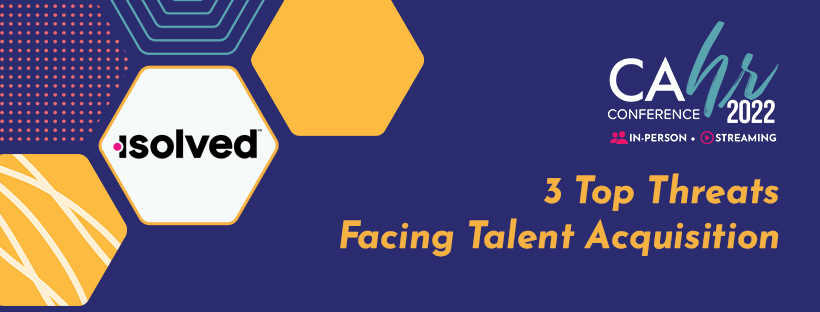3 Top Threats Facing Talent Acquisition
3 Top Threats Facing Talent Acquisition
|
No one would argue that the working world has completely changed over the last few years. More employees are working from home. Zoom calls are the norm. And The Great Resignation has upended traditional talent acquisition and has left organizations scrambling to put the pieces back together. Recruiting and hiring are among the biggest challenges facing HR professionals since the pandemic started. HR teams are doing their best to keep up with the changing dynamics, but there is no denying the shifts that have occurred in the employment landscape. In a recent survey of 500 HR leaders, 48 percent say they expect recruiting to be more difficult in 2022. Here are the main reasons why: 1. Competitors with Bigger Budgets As prices continue to skyrocket across the globe, salary is a big motivator when accepting a job offer. In fact, a whopping seventy-five percent of job seekers report salary is the biggest factor they consider when considering a potential job offer. This data, along with 8 percent of the surveyed HR leaders saying that their organizations are unable to pay market value for talent, can certainly have an impact on attracting talent to open positions. Benefit offerings are also top of mind for candidates. HR leaders are taking note, with more than half of those who were surveyed saying their organization needs to improve its health insurance offering to stay competitive in the market. Other benefits in the spotlight include paid time off (PTO) and retirement plans, with 43 percent of HR leaders reporting their company needs more competitive PTO policies and 38 percent identifying retirement plans as an area of improvement for their benefit offerings. 2. Desire for Remote Work Employers can adjust their business model to accommodate employees’ evolving preferences, but sometimes that simply isn’t possible. Businesses are as unique as the people they employee and business goals and needs can vary, making remote work incompatible in some cases. However, being aware of what applicants are looking for can help when promoting job openings. Simply advertising the work from home or in office expectations in job ads may lead to more compatible applicants. 3. Lack of Qualified Candidates While it may not be possible to find a larger talent pool, employers can invest in their own workforce by offering career growth and professional development opportunities. This will go a long way, as the aforementioned employee survey revealed that 22 percent of respondents would like their employer to engage them by providing more learning opportunities. Better engagement leads to better employee experience, and a better employee experience can lead to an increase in retention. When an employer can retain top talent, the need for new talent decreases. Solutions: Leveraging What Works Employee referrals, for example, can make a huge impact. In fact, 22 percent of HR leaders identified referrals as their most valuable recruiting tool. One way to increase the number of referrals within an organization is to offer incentives. In the employee survey, respondents noted that they prefer cash bonuses, followed by extra PTO, company-wide recognition or prizes like fitness watches, headphones, or a tablet. While referrals can make a big difference, it’s important for every organization to tap into what works best for them. For some that may be employee review sites and for others it may be their recruiting and hiring software. Regardless of what HR teams are tapping into, identifying current challenges in the employment landscape is a good starting point when also searching for new opportunities. About isolved Register now for CAHR22. Take advantage of a variety of attendance options designed to align with your needs and budget! We can’t wait to see you, in Anaheim or streaming live. |
 |


